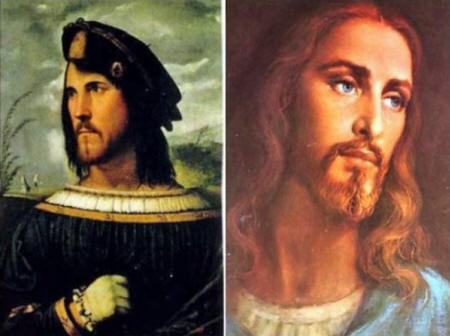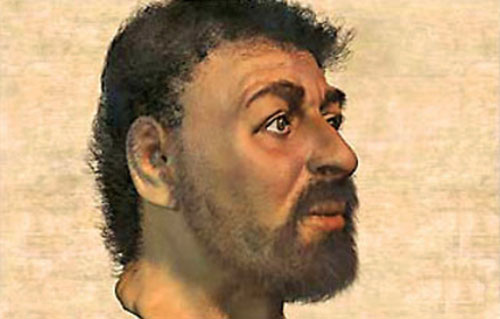|
by Valerie Tarico from ValerieTarico Website
Lyrics for the rap song, B.I.B.L.E. (Basic Instructions Before Leaving Earth), include the following line: The idea that our modern image of Jesus could be based on a ruthless power-hungry illegitimate son of a pope is startling and farfetched. But it is no more bizarre or fanciful than many other ideas about who Jesus was or what he looked like.
And it does have an interesting tale behind it.
To understand the Borgia story requires a bit of context.
It's All Guesswork
In contrast to what many people believe, we have no authentic physical artifacts confirming the gospel stories, nor descriptions of Jesus from any of his contemporaries.
Even the gospels themselves never claim to be eyewitness accounts. Scholars now believe that the stories of Jesus' life and ministry that have been handed down to us - both within the Bible and outside - were written decades (or more) after Jesus would have lived, by unknown authors.
This means that Christians have been free for almost two millennia to depict Jesus in a form that best suits their own culture and purposes, and they have.
Not long ago a picture of a cherubic golden-haired Jesus circled Facebook with the following caption,
The answer, obviously, lies more in the psychology of human racism than in any likely historical reality.
In 2002, forensic anthropologist Richard Neave, analyzed skeletal remains of Semitic men from the first century and applied the tools of his trade to construct a model showing a "most likely" head of Jesus.
His model is broad featured and swarthy, with a wide face framed in the beard and cropped, tight-curled hair characteristic of Jews at that time. The head is scaled for a muscular male frame about 5"1" in height, average for the time and place.
As author Mike Fillon put it,
The Evolution of Jesus
Fillon could have added another word to his description of the standard American Jesus: hot. (Former Catholic, Julia Sweeney, jokes in her monologue, Letting Go of God, that the Jesus on her childhood bedroom wall helped her discover the pleasures of her own body.)
The eyes of a standard American Jesus, whether brown or blue, are intense; his skin flawless; his features either aristocratic or classically masculine. Even on the cross, his muscles are well defined.
In a culture that cares tremendously about youth and beauty, Jesus is a fine specimen of manhood.
But that was not always the case.
The earliest Christians depicted Jesus via pictograms such as the anchor, peacock, or the still popular fish. Jesus worship at the time was furtive but also imbued with the Jewish aversion to "graven images," and early Christian leaders sought to differentiate their emerging religion from pagan traditions that used statues and other art to symbolize Gods.
Church fathers including Irenaeus and Clement wrote disapprovingly about any image representing Jesus, and the Synod of Elvira in 306C.E. forbade it. Also, at least some early Christians believed Jesus was quite ordinary in appearance.
Justin and Tertullian cited words they believed to be a prophecy from the book of Isaiah:
In the Quran, Mohammed flies to Jerusalem where he meets with Abraham, Moses and Jesus, and Jesus is the smallest of the three.
Other early writers describe Jesus as slight, ordinary, and even unattractive. These writings cannot be assumed to give a picture of any actual historical Jesus, but they do reflect images circulating at the time they were written.
Over time as Judaism and Christianity adapted to the Roman Empire, both traditions softened to religious art with human figures. Third century images show Jesus as an infant and then a beardless youth, dressed and groomed according to the fashions of the time.
After Constantine declared Christianity the official religion of the Roman Empire in the 4th century, artists merged Jesus into traditional images of the regal Sol Invictus, the unconquered sun, just as the birth celebration of Sol Invictus at the end of December became the birthday of Jesus.
Jesus Matures, Becomes Tall and Beautiful
It wasn't until the early Middle Ages that Christian iconography converged on the bearded, mature Jesus familiar today.
Around the same time, writers and artists sought to show that Jesus had outward beauty and stature to match his spiritual beauty and Divine origins.
Forged writings and fake artifacts have been common throughout Christian history - from the New Testament books written in the name of Paul to modern manuscript fragments hinting at the marital status or sexuality of Jesus - and in the Middle Ages, forged relics helped to create the modern image of Jesus.
The Shroud of Turin, which was just one of many Jesus shrouds in circulation at the time it appeared in the 14th Century, "revealed" a Jesus who was tall (5'11 - 6'), with long hair and beard surrounding a long face.
In the 15th century, a letter from a Roman Governor of Judea, Publius Lentulus, to Tiberius Caesar emerged.
The forged letter, now housed in the Library of Geranini in Rome, waxes eloquent about the physical presence and beauty of Jesus:
Back to Borgia
In this context - the absence of physical or eye witness evidence, the evolution of Christianity, the fusion of Christianity and political power in Rome, and the convergence on a regal, beautiful Jesus - we can return to the Borgia story.
As the tale goes, European crusaders were troubled by the idea of killing Middle Easterners who looked like Jesus, and the ecclesiastical powers of the Catholic hierarchy wanted to assure crusaders that Jesus was not at all like the people they were slaughtering.
Cesare Borgia had the perfect visage to provide an alternative.
The story likely derives from portraits of Borgia, for example here, here, and here, and the similarity to many paintings of Jesus, as in this side by side pairing.
Also, Borgia is said to have employed Leonardo Da Vinci as a military engineer from 1502-1503, which has led to speculation that Borgia's visage could have influenced Da Vinci's religious art.
However, the Crusades that focused on the Holy Land, those which would have required crusaders to slaughter primarily civilians of Middle Eastern descent, occurred centuries before either Borgia or Da Vinci lived.
Crusades during the 14th and 15th Century were fought primarily to defend or reclaim previously Christian territory from the expanding Ottoman empire in regions that are now part of Europe or Turkey.
Any similarity between paintings of Borgia and Jesus is more likely attributable to the fact that both were influenced by European aesthetic preferences and ideas of what powerful men should look like - which is a story of its own.
Deeper Realities Behind the Borgia Jesus Story
The Borgia-Jesus connection, while apocryphal, has resonated with many people in part because it lines up with aspects of Christian history that are grounded in much better evidence.
We know that popular images of Jesus were adapted to cultures where Christianity was being promoted or had gained broad acceptance.
We know that these images were modified and refined for purposes that were political as well as devotional (for example, the images of Jesus as Sol Invictus). And we know, beyond a shadow of a doubt, that Medieval Christians sought to distance themselves from the Jewishness of Jesus.
Medieval Europe forced Jews into ghettos, pioneered the arm band that was resurrected by the Nazis, caricatured Jewish physical features in art and literature (think Shakespeare's Shylock), and invented the "blood libel" that still crops up among Islamists and at conspiracy sites.
Small wonder then, that a story about the Church seeking to whiten Jesus in order to further dehumanize Semitic people has some resonance.
More broadly, the story says something about each person's tendency to create God in his or her own image and in the words of Anglican theologian Charles D. Hackett, to,
At its most benign, this tendency is illustrated by a popular Christmas carol:
The song is tender and speaks to the broad appeal of a special baby sent by a God who loves us. The idea of little children picturing a baby Jesus like them is sweet.
But the inability of adults to think beyond the constraints of our own race and culture is less heartwarming. And simply depicting Jesus in different colors, as the song does or as some artists have done in recent years, doesn't solve the problem.
As one African commenter observed online:
How many people would accept him even as a 1st century rabbinical Jew?
Only in the last few decades have scholars begun to explore what it might mean to really understand the figure of Jesus as a man of his time and place, both physically and spiritually.
Dozens of books have been written on the topic in recent years, by Christians, secular scholars, and Jews.
Even so, Christian animosity toward Jews persists unabated in some sectors. Mel Gibson's anti-Semitic torture porn, The Passion of the Christ, sold to full houses of bussed-in churchgoers. More recently, when Bonnie Weinstein of the Military Religious Freedom Foundation published a book of wildly anti-Semitic hate mail from Christian fundamentalists, she received more of the same.
In an effort to distance themselves from the image of a Semitic Jesus some conservative Christians have even laid out the following (transparently self-serving) argument:
This means Jesus had some unknown kind of DNA that came straight from God, and so he could have had any shape of face, eye color, skin tone, build or height.
Ergo, there's no reason to assume that he looked like a typical Palestinian Jew.
Whew. Now we can all go back to picturing Mark Ryder or Diogo Morgado or whichever modern imaginary Jesus most inspires our spiritual - or carnal - devotion...
That
are Probably Wrong from ValerieTarico Website
Jesus has been described as the best known figure in history, and also the least known.
If you mentioned the name "Jesus" and someone asked Jesus who?, you might blink. Or laugh...
Even people who don't think Jesus was God, mostly believe they know a fair bit about him. You might be surprised that some of your most basic assumptions about Jesus are probably wrong.
We have no record of anything that was written about Jesus by eyewitnesses or other contemporaries during the time he would have lived or for decades thereafter, and as best scientists can tell, all physical relics of his life are later fakes.
Nonetheless, based on archeological digs and artifacts, ancient texts and art, linguistic patterns, and even forensic science, we know a good deal about the time and culture in which the New Testament is set.
This evidence points to some startling conclusions about who Jesus likely was - and wasn't.
The person of Jesus, if indeed there was a single historical rabbi at the root of our traditions, is shrouded in the fog of history leaving us only with a set of hunches and traditions that far too often get treated as knowledge.
The "facts" I have listed here are largely trivial; it doesn't really matter whether Jesus was tall or short, or how he cut his hair. But it does matter, tremendously, that "facts" people claim to know about how Jesus saw himself, and God and humanity are equally tenuous.
In the words of Mark Twain:
The teachings attributed to Jesus mix enduring spiritual and moral insights with irrelevancies and Judaica and bits of Iron Age culture, some of which are truly awful.
That leaves each of us, from the privileged vantage of the 21st century, with both a right and a responsibility to consider the evidence and make our own best guesses about what is real and how we should then live.
A good starting place might be a little more recognition that we don't know nearly as much as we'd like to think, and a lot of what we know for sure is probably wrong.
|


